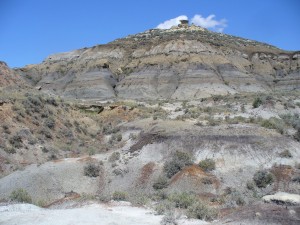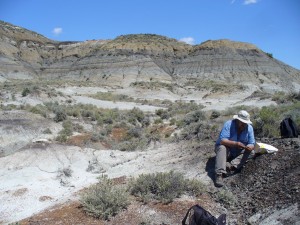17 December 2014
An updated geological timeline for the extinction of the dinosaurs
Posted by kwheeling
By Chris Cesare

The Hell Creek Formation in Eastern Montana was an ancient river and floodplain. Now, scientists are using its pristine formations to provide a more accurate timeline of the events surrounding the extinction of the dinosaurs.
Credit:Courtney Sprain
The asteroid that smashed into the Yucatan Peninsula a little more than 66 million years ago left behind the Chicxulub crater, but it also left behind something else: iridium, a rare element, which settled in a fine layer all over the world. When scientists discovered this layer between rock strata in the 1980s, it eventually led them to the crater as well, and an explanation for the disappearance of the dinosaurs.
“This is the mass extinction that’s probably best known to non-scientists because dinosaurs are cool and they all died,” said Courtney Sprain, a doctoral student in earth and planetary sciences at the University of California, Berkeley.
But on either side of that layer, which serves as a geological boundary between the Cretaceous and the Paleogene, determining the age of rock is more difficult. This fuzziness makes it harder for paleontologists to piece together the timeline of life’s evolution after the mass extinction, which included the emergence of humans and all other mammals.
Now, Sprain and Paul Renne, her adviser and the director of the Berkeley Geochronology Center, have combined techniques for geological dating to pinpoint two ancient changes in the Earth’s magnetic field on either side of the boundary, finding that previous estimates were more than 100,000 years too big. Sprain presented the work Tuesday afternoon in a poster at the American Geophysical Union’s Fall Meeting in San Francisco.
To determine their refined estimates, Sprain and Renne first took samples from the Hell Creek Formation in eastern Montana, the location of an ancient river and its floodplains. The site contains several layers of coal with minerals that can be dated by measuring the relative amounts of two argon isotopes, variants of the element with different numbers of neutrons.

Renne digs through a coal deposit at Hell Creek. Minerals in the coal helped date the deposit using the relative abundance of different argon isotopes.
Credit: Courtney Sprain
The ages of the minerals in the coal and the vertical distance between two coal deposits allowed the researchers to calculate the average rate that sediment settled on the ancient riverbed. Then, by measuring the magnetic properties of the minerals, they were able to search for the ancient magnetic signature they were seeking.
“Magnetic minerals want to align with a magnetic field, and Earth has a magnetic field,” Sprain said.
When the minerals fell to the bottom of the ancient river, they aligned with the Earth’s magnetic field. But the Earth’s field reverses at irregular intervals, and these switches leave imprints on the minerals in rocks. By measuring the direction that these miniature magnets pointed at different heights of the rock formation, Sprain and Renne pinpointed two reversals of the Earth’s field on either side of the massive extinction that killed the dinosaurs. They found that the time between these two flips was about 600,000 years, with an uncertainty of about 60,000 years. Previous estimates of the same duration were more than 700,000 years, and they lacked a good account of their uncertainty.
Pinpointing those magnetic field flips is useful for other scientists, who rely on the dates of these reversals to calibrate their own estimates of other geological or paleontological findings, Sprain said.
“We want to help improve the chronology around the boundary so groups around the world can use it,” she said.
Chris Cesare is a science communication graduate student at UC Santa Cruz.










 GeoSpace is a blog on Earth and space science, managed by AGU’s Public Information staff. The blog features posts by AGU writers and guest contributors on all sorts of relevant science topics, but with a focus on new research and geo and space sciences-related stories that are currently in the news.
GeoSpace is a blog on Earth and space science, managed by AGU’s Public Information staff. The blog features posts by AGU writers and guest contributors on all sorts of relevant science topics, but with a focus on new research and geo and space sciences-related stories that are currently in the news.